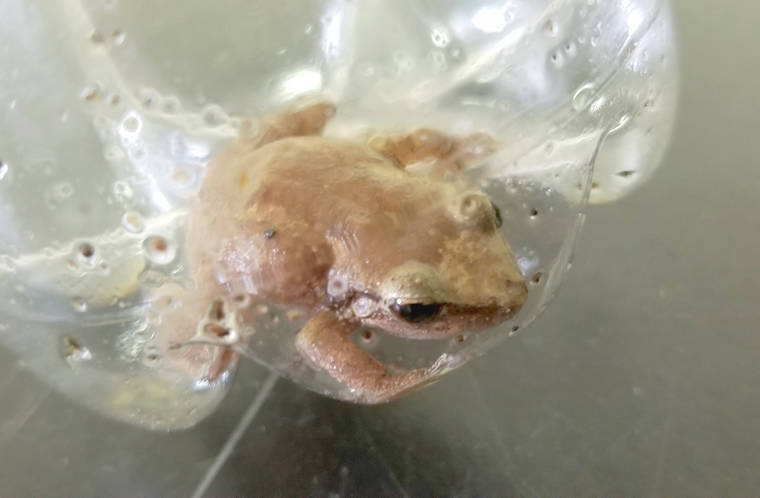LIHUE — It takes your eyes to protect the island against invasive species.
That’s proven time and time again, with everything from coqui frogs to miconia, according to members of the Kauai Invasive Species Committee, who say many of the invasive species they tackle are reported by the public.
“A great recent example was a report of miconia spotted by two alert hikers in the Wailua area,” said Jenny Allen, outreach person for KISC.
“They recognized the invasive plant and quickly sent a photo and GPS location to KISC. Following the report, the KISC crew located and removed a number of previously undetected young miconia adjacent to the existing buffer area.”
Miconia is an invasive, fast-growing plant with large leaves that invades the space of other plants. It has a large, shallow root system that leads to landslides and erosion, according to the state Department of Land and Natural Resources.
The plant has large, oval leaves that are a vibrant purple on the bottom. It can grow from 13 to 50 feet high.
It’s known to have invaded three areas of Kauai — Wailua River State Park, Wailua Homesteads and the Wailua Game Management Area.
Hikers around there will see signs at trailheads that explain the impacts and describe miconia, complete with photos that show what to look for.
Coqui frogs are another of those species that invasive species experts are intent on keeping out of Kauai. They’re tiny frogs (about an inch long or smaller) with a loud chirp. They don’t have any natural predators, breed quickly, and usually travel between islands in plants or vehicles.
They’re all over Hawaii Island, where reportedly their calls have become deafening in some areas, and are also on Maui, Oahu and Kauai.
Kauai is doing everything it can to keep them at bay. So far this year, KISC has assisted the Hawaii Department of Agriculture in capturing nine coqui frogs from four locations on Kauai.
In April, two were captured in the Nawiliwili area.
In 2001, a breeding population was discovered on 10 acres in Lawai, according to KISC. That population wasn’t eradicated until 2012. The frogs have also been reported in Kapahi.
KISC Project Manager Tiffani Keanini said putting a stop to the spread of the frogs in those areas has been a group effort.
“The Kauai community has been essential in keeping coqui from establishing on Kauai by quickly reporting any calling frogs,” she said.
There are two “look-alike” frogs on Kauai that could be mistaken for coqui — the greenhouse frog and the Japanese wrinkled frog. The greenhouse frog has warty, textured skin, is found only on the ground (versus in bushes and trees). The Japanese wrinkled frog is a little larger the coqui and isn’t known to be found in trees, either.
KISC is also partnering with state officials to generate public awareness of rat lungworm disease, which is spread through snails and slugs and can infect humans who eat those snails and slugs, or plants that carry their slime.
In 2018, 10 cases of the disease were confirmed and, in the early months of 2019, two visitors contracted rat lungworm disease while traveling — making five confirmed cases this year.
Thursday, get information on rat lungworm disease from experts in a workshop at Kawaikini School in Puhi, next to Kauai Community College, from 8:30 a.m. to 3:30 p.m.
Report coqui frogs and other invasive species to KISC at 821-1490 or HDOA at 643-PEST.
•••
Jessica Else, environment reporter, can be reached at 245-0452 or jelse@thegardenisland.com.


And we can’t forget the parakeets, they certainly did not forget our lychee tree.